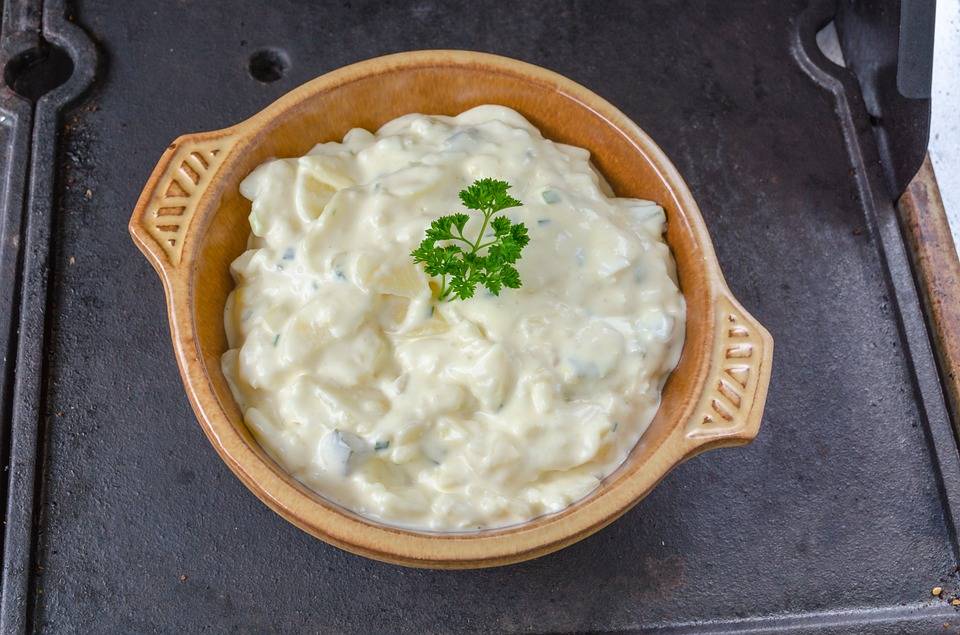There is a legend about the origin of mayonnaise. It says that this sauce was invented by a chef of the French garrison, which was locked by the British on the island of Menorca in the city Mahon (Mayon). The besieged experienced problems with food – there were only olive oil and turkey eggs, and the officers were only fed on fried eggs. Then the French commandant’s personal chef – thoroughly grated egg yolks with sugar and salt, mixed it all with olive oil, and finally, added lemon juice into the mixture. Thus, the classic mayonnaise was created. This wonderful sauce quickly gained its recognition and became known as “mahon sauce” or “mayonnaise”.
However, the Spaniards insist on their authorship, arguing that the treacherous French usurped the glory of their “ali-oli” sauce, popular in South Europe since Virgil.
In the early 19th century a French chef made mayonnaise with mustard, which gave it a delicious and piquant taste. Besides, mustard, being an excellent emulsifier, it improved the sauce durability in a long-term storage. This kind of mustard sauce got the name “Provencal sauce from Mahon” or more familiar to us name – “Provence” mayonnaise.
Today there are many recipes of mayonnaise with different proportions of ingredients, but the determining factor of this product is the fat content. According to European standards, with regard to the fat content, the product is referred to as “mayonnaise” (at 80% of fat), “salad mayonnaise” (at 70-50% of fat) and salad dressing (at 49-20% of fat).
Using the language of the food industry technologists, we can describe mayonnaise as “oil in water” fine emulsion, prepared from egg powder, milk powder, mustard powder and vegetable oil with the addition of emulsifiers, flavorings and spices. Thus, the main task of a technologist in this regard – is to obtain a homogeneous, stable substance, taking into account the concentration of the dry components and the degree of their swelling – by adjusting the flow of the oil, and the level of mechanical and hydro-mechanical equipment.
A mayonnaise production line consists of several compulsory sets: a section of components resting, tanks for steam treatment, the main mixer tank, and a homogenizer or colloid mill.
To obtain a high-quality product, the raw materials have to meet certain requirements. For example, vegetable oil (sunflower, soya, olive, corn, peanut, and others), serving as one of the main components, must pass through a refining process, including deodorization, and used within a period of one month since refining.
The following ingredients are used in dry form: egg powder, powdered cow’s milk (skimmed or whole), mustard powder, sugar, and salt. Vinegar is used in the form of a 9-10% solution of acetic acid.
The preparation of mayonnaise consists of a series of steps: first, you prepare the ingredients according to the recipe. The dry ingredients: egg and mustard powder, powdered milk, sugar, salt, soda are weighed on the scales, and then sifted through a fine-meshed sieve. Sifting through a sieve breaks large lumps, improving the moisture-retaining capacity of the powders. The required amounts of vegetable oil and water are poured out into the appropriate storage tanks.
Usually, egg paste is cooked first. For this – egg powder and water are delivered into a mixing tank. The mixture is stirred with a paddle-type mixer for about 2 – 10 minutes. Then it is heated to 60-65°C and held for 15-20 minutes, then pumped through a homogenizer into the main mixing tank to let it cool down to 20-30°C.
In the second tank, mustard and milk blend is prepared. A homogenizer evenly distributes the dry ingredients (milk powder, mustard powder, salt, sugar and soda) in the water and a colloid mill provides an additional grinding of the solid fractions (if necessary). The obtained mixture sits for 20 minutes at 80-85°C for a better dissolving and pasteurization of the components, and then it is allowed to cool down to 20-30°C. Cooled down mustard and milk paste is also pumped into the main mixing tank.
In the main mixing tank egg paste and mustard-milk paste are stirred for 5-10 minutes with a paddle-type agitator to obtain a homogeneous paste. The weight ratio of mustard-milk and egg pastes range from 1.5-2.0:1 for high-calorie mayonnaise and 2.2-2.8:1 for medium and low-calorie.
At the next stage vegetable oil is delivered into the main mixing tank. For an even distribution the oil is spread with a thin jet into the mixture of egg and mustard-milk pastes, that it is passed through a homogenizer.
Simultaneously with the introduction of the last portions of vegetable oil the previously prepared cold (15-16°C) vinegar-salt solution is introduced.
The sequence and speed of adding vegetable oil and vinegar-salt solution into the paste are extremely important, because the simultaneous or accelerated introduction of these components can result in emulsion getting lumpy.
At the final stage a coarse mayonnaise emulsion, from the mixer tank is pumped through a homogenizer or a colloid mill. Homogenization is continued until a stable emulsion is obtained. As practice shows, this requires all mayonnaise emulsion to be passed through a homogenizer at least 2-3 times.
If the sample taken is entirely homogeneous, has no lumps, runs evenly and has a typical for mayonnaise viscosity, color, taste and smell – the product is considered to be ready and is subject to packaging.
Mayonnaise is stored at 3-7°C. Freezing or excessive heat of mayonnaise destroys its structure, besides a high temperature dramatically reduces the shelf life of this remarkable product.



